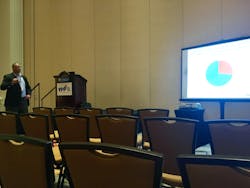VPPPA 2016: OSHA Wants Companies to Stand Down for Safety
Despite OSHA’s continuing efforts to educate employers about fall protection and hazards, falls remain the leading cause of fatalities in the construction industry.
Brian Sturtecky, OSHA’s Jacksonville, Fla office area director, kicked off a presentation about OSHA’s National Campaign to Prevent Falls on the second day of the 32nd Annual VPPPA National Conference in Orlando, Fla.
Fall hazards exist everywhere and the majority of injuries and deaths are occurring in the afternoon and on Fridays when employees are exhausted after a long work day or looking forward to the weekend, Sturtecky said.
“Things happen – what are you doing to make sure they don’t?” he told the audience. “We (OSHA and the employer) need to work together. If we’re not talking about it and you’re having trouble, nothing is going to get done.”
Many of the fatalities Sturtecky’s office recently investigated were ladder falls from 7 ft. to 15 ft.
Non-routine tasks attempted on A-frame ladders could cause a worker to fall because they take “just a second.” In most situations, the employee is reaching too high, too far or is using the top step when they shouldn’t. To drive the point, Sturtecky recounted a recent fatality in which an employee working a palm tree fell from a ladder and hit his head.
The residential construction industry particularly has been a challenge for OSHA, he said. National homebuilders are continuing to hire contractors that are not trained or protected from fall hazards.
Sturtecky noted a consistent lack of proper harness and PPR use. Of the 90 to 95 percent of residential inspections performed by his office, almost every single contractor is failing to take proper fall prevention measures.
“We tend to see people wear a harness and that’s it,” he said. “It’s holding your pants up, but that’s all it’s doing. You need an anchor point.”
Standing Down
Once Sturtecky completed his portion of the presentation, Americo Pagan, OSHA’s Region IV assistant regional administrator provided recommendations to attendees about when and how to host a safety stand down.
A stand down is a voluntary event for employers to talk directly to employees about safety, and specifically, fall protection. The training or presentation typically focuses on a hazard or a couple areas where the company should improve or correct fall hazards and is not limited to any specific industry.
“The goal is to do something before something happens,” Pagan said.
Employees will retain more knowledge if sessions are around one hour and occur before the work day is in full force, he said. However, if multiple hazards are discovered during a review of company logs, a longer program can be organized.
Pagan suggested the following activities for an organized stand down event: toolbox talks focused on two to three topics, webinars, videos, personal testimonies, PowerPoint presentations and hands-on, practical demonstrations.
How to Conduct a Stand Down:
- Try to start early
- Think about subcontractors, owners or others associated with the site/project who should participate in the stand down
- Review your fall protection strategy and determine what you areas in which you need to focus
- Develop presentations or activities that will meet your needs
- Decide when to hold the stand down and how long it will last
- Promote the stand down
- Hold the event
Resources including a fall protection training guide and pre-made presentations are available on OSHA’s website.
